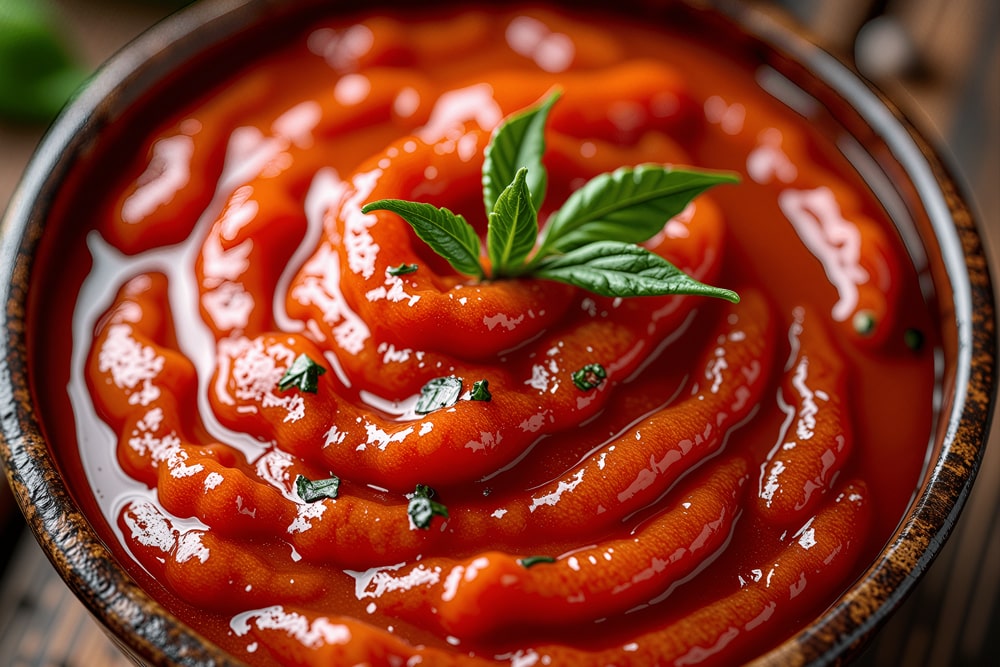
The Roasted Tomato Sauce is an all round, delicious condiment, used over the centuries across all kinds of dishware's. It is classic in Italian cuisine where it is normally served with pizza or pasta. Roasting improves the inherent sweetness of the tomatoes and gives the taste slightly smoky nature. There is a range of customization of this sauce; a smooth pureed and conversely a hearty-looking sauce that can be used in different food preparations. Before why is a fun fact: Tomatoes were considered love apples and were aphrodisiac!
| Nutrient | Amount (per serving) |
| Calories | 80 kcal |
| Protein | 2 g |
| Carbohydrates | 7 g |
| Fiber | 1 g |
| Fats | 4 g |
| Vitamin C | 30% of RDA |
| Lycopene | 12 mg |
4 (makes about 2 cups of sauce)
| Ingredient | Quantity |
| Ripe tomatoes | 6 large |
| Olive oil | 2 tbsp |
| Garlic cloves | 3, unpeeled |
| Onion, quartered | 1 medium |
| Fresh basil leaves | 1/4 cup |
| Dried oregano | 1 tsp |
| Salt | To taste |
| Black pepper | To taste |
| Aspect | Description |
| Texture | Smooth and velvety |
| Color | Deep red with caramelized tones |
| Smell | Rich, smoky, and herby |
| Taste | Sweet, tangy, and slightly smoky |
| Thickness | Medium, pourable consistency |
This Roasted Tomato Sauce should be served hot or cold, depending on the meal. Serve it with pasta, or serve it as a pizza crust or as a breadstick with dip. Drizzled as well can be served over the roasted vegetables or could be placed in the casserole to add flavor.
Roasted tomato sauce is a topping that is so easy and fancy to serve with any meal. Its free-friendliness to the gastroparesis, daring tastes, and its multi-purposes make it a simple ingredient in healthy cooking. You are dressing up your pasta or adding a little cherry of homemade on your pizza this sauce is guaranteed to get you very excited. Taste it today and listen to the roast flavor!
Tomatoes are roasted and pureed and the results provide we soft texture that will not strain the stomach but will be easily digested.
When tomatoes are roasted, this increases the bioavailability of lycopene which is a potent antioxidant, good to the gut and also lowers inflammation.
Yes, in its strained and roasted form to eliminate seeds and skin, tomato sauce becomes low in fiber to meet the requirements of low-fiber diets.
The components of olive oil are anti-inflammatory which aid in the calming of the digestive system and reduce gut swelling.
Indeed, roasted garlic contains anti-inflammatory features with a healthy digestive tract.
Tomatoes contain much water hence help to keep the body hydrated and free of stomach upsets they are also lightweight.
In order to make a soft, smooth and gentle sauce, roast tomatoes and puree (strain) to eliminate seeds and skins.
Yes, because it has low amounts of fiber and has a smooth texture, people with gastroparesis can generally tolerate it.
It is definitely an excellent pasta, soups and other food base that needs to be used in dishes which demand a moderate tomato taste.
Keep it tightly enclosed in refrigerator where it may stay up to 5 days or may be frozen to keep longer.